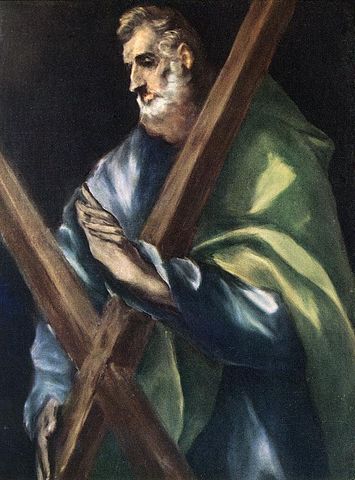A man walked by the sea where fishermen landed their boats, unloaded the fish, and worked on their nets. He summoned two men from the many present on the beach that day with a single gesture. He didn’t know them personally, but he evidently saw something in the two of them that told him that they were men he could trust, teach, and who would carry on his work. Their names were Peter and Andrew bar Jonah, and they had just met the man who would change their lives forever.
Andrew became one of the 12 disciples. Legend has it that he was the first one chosen, although Peter might have been the elder as he was already married when Jesus called him and his brother. They followed Jesus, learned from him, and took his teachings out into the world both before and after the Resurrection. Andrew became a missionary to Greece and Asia Minor, possibly including parts of Russia and Poland. He was martyred in the city of Patras, Turkey, by crucifixion on an X-shaped cross, called a saltaire, which became one of his more customary symbols. Following his death, his relics were gathered and hidden as per a dream given to St. Regulus, who did as the vision commanded. In 356, Constantinus II ordered that the relics should go to Constantinople, but Regulus had another dream in which he was told to take what relics he had not sent and put them on a ship to sail to the end of the earth. The boat wrecked on the western coast of Scotland near the town of Kilrymont, later renamed St. Andrew’s in honor of the saint.
Festivals celebrating St. Andrew have been held in Scotland since sometime around 1000 CE, and in 1320, Andrew was made the patron saint of Scotland. The saltaire-shaped cross of his martyrdom became part of the Scottish flag and was incorporated later into the flag of the United Kingdom. His relics were placed in a chapel in the Cathedral of St. Andrews, a medieval church built in the 11th century. When the monasteries and religious places were pillaged and desecrated at the time of the Reformation, the Scottish relics were shipped to Rome, where many of them remained.
Many people are familiar with St. Andrews, Scotland, not so much for the saint himself but for the game of golf. It is one of the oldest and most prestigious golf courses in the world. Golf has been played in various forms in far-flung parts of the world, but the course at St Andrew’s is where the 18-hole game we know today was established (previously it had been 22), as well as a code of standards for the course and the game. For many golfers, a trip to and a chance to play a round at one of the four courses at St. Andrews is the equivalent of a trip to Jerusalem, and probably as expensive as a trip to the Holy City, with accommodations, and tours included.
Needless to say, St. Andrew is a patron saint of fishermen, and places such as Scotland, Romania, Ukraine, Patras (the city in Turkey where most of his relics are now located), and Barbados. His patronages also include singers, single laywomen, anglers, farmworkers, pregnant women, and golfers. Religious medals honoring St. Andrew are for sale in religious stores, but there are also medals for those golfers who wish to invoke the blessing of their patron saint as they walk or drive their golf carts from hole to hole like a journey to a sacred shrine such as Compostela or Jerusalem. There are also golfing rosaries, with small replicas of golf balls marking off the prayers. What will they think of next?
Many of us look at St. Andrew primarily on his feast day. Churches sometimes celebrate the day with the Kirking of the Tartans. Those of Scottish descent bring a piece of their tartan to lay on the altar rail, parishioners wear their clan kilts, and often bagpipe and drum bands play processionals and recessionals, with the eerie and sometimes heart-pounding sound of the old country bouncing from the ceiling and walls. It’s been compared to the wailing of lost souls, but it is also a significant part of the Scottish identity, a soul-stirring reminder of the reason wars have been fought, brave men summoned, and the dead remembered – just not on the golf course, please!
Gum beannaicheadh Dia thu. God bless.
Image: St. Andrew, by El Greco (painted ca 161-1614). From the El Greco Museum, Toledo, found at Wikimedia Commons.
Linda Ryan is a co-mentor for an Education for Ministry group, an avid reader, lover of Baroque and Renaissance music, and retired. She keeps the blog Jericho’s Daughter. Her domestic fur-kids, Dominic, Gandhi, and Phoebe, keep her company and often quite amused. This week’s excitement is putting up the Christmas tree! Let joy be unrestrained!

